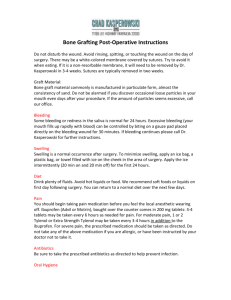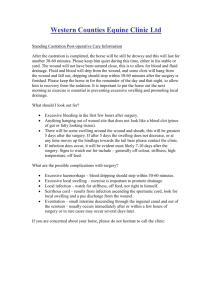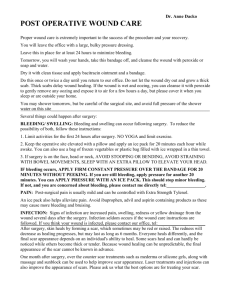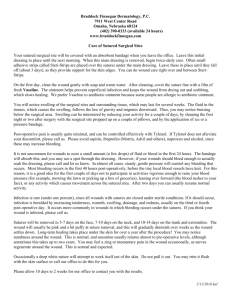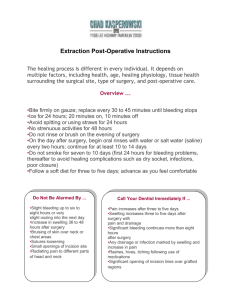skingraft312 - Seacoast Skin Surgery
advertisement
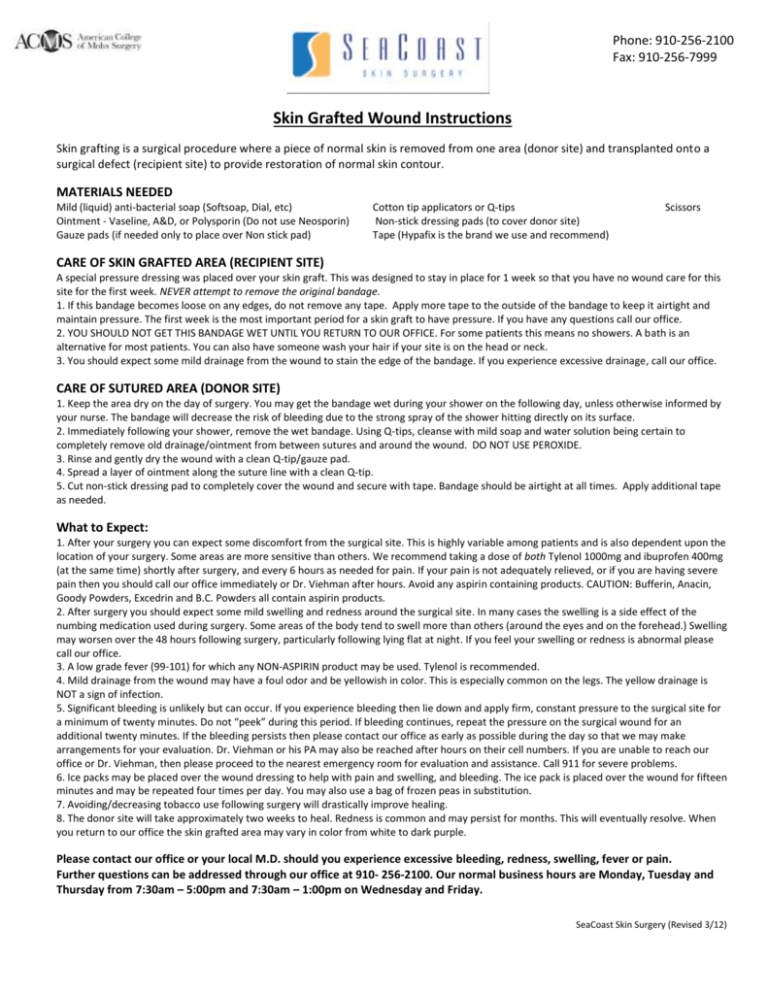
Phone: 910-256-2100 Fax: 910-256-7999 Skin Grafted Wound Instructions Skin grafting is a surgical procedure where a piece of normal skin is removed from one area (donor site) and transplanted onto a surgical defect (recipient site) to provide restoration of normal skin contour. MATERIALS NEEDED Mild (liquid) anti-bacterial soap (Softsoap, Dial, etc) Ointment - Vaseline, A&D, or Polysporin (Do not use Neosporin) Gauze pads (if needed only to place over Non stick pad) Cotton tip applicators or Q-tips Non-stick dressing pads (to cover donor site) Tape (Hypafix is the brand we use and recommend) Scissors CARE OF SKIN GRAFTED AREA (RECIPIENT SITE) A special pressure dressing was placed over your skin graft. This was designed to stay in place for 1 week so that you have no wound care for this site for the first week. NEVER attempt to remove the original bandage. 1. If this bandage becomes loose on any edges, do not remove any tape. Apply more tape to the outside of the bandage to keep it airtight and maintain pressure. The first week is the most important period for a skin graft to have pressure. If you have any questions call our office. 2. YOU SHOULD NOT GET THIS BANDAGE WET UNTIL YOU RETURN TO OUR OFFICE. For some patients this means no showers. A bath is an alternative for most patients. You can also have someone wash your hair if your site is on the head or neck. 3. You should expect some mild drainage from the wound to stain the edge of the bandage. If you experience excessive drainage, call our office. CARE OF SUTURED AREA (DONOR SITE) 1. Keep the area dry on the day of surgery. You may get the bandage wet during your shower on the following day, unless otherwise informed by your nurse. The bandage will decrease the risk of bleeding due to the strong spray of the shower hitting directly on its surface. 2. Immediately following your shower, remove the wet bandage. Using Q-tips, cleanse with mild soap and water solution being certain to completely remove old drainage/ointment from between sutures and around the wound. DO NOT USE PEROXIDE. 3. Rinse and gently dry the wound with a clean Q-tip/gauze pad. 4. Spread a layer of ointment along the suture line with a clean Q-tip. 5. Cut non-stick dressing pad to completely cover the wound and secure with tape. Bandage should be airtight at all times. Apply additional tape as needed. What to Expect: 1. After your surgery you can expect some discomfort from the surgical site. This is highly variable among patients and is also dependent upon the location of your surgery. Some areas are more sensitive than others. We recommend taking a dose of both Tylenol 1000mg and ibuprofen 400mg (at the same time) shortly after surgery, and every 6 hours as needed for pain. If your pain is not adequately relieved, or if you are having severe pain then you should call our office immediately or Dr. Viehman after hours. Avoid any aspirin containing products. CAUTION: Bufferin, Anacin, Goody Powders, Excedrin and B.C. Powders all contain aspirin products. 2. After surgery you should expect some mild swelling and redness around the surgical site. In many cases the swelling is a side effect of the numbing medication used during surgery. Some areas of the body tend to swell more than others (around the eyes and on the forehead.) Swelling may worsen over the 48 hours following surgery, particularly following lying flat at night. If you feel your swelling or redness is abnormal please call our office. 3. A low grade fever (99-101) for which any NON-ASPIRIN product may be used. Tylenol is recommended. 4. Mild drainage from the wound may have a foul odor and be yellowish in color. This is especially common on the legs. The yellow drainage is NOT a sign of infection. 5. Significant bleeding is unlikely but can occur. If you experience bleeding then lie down and apply firm, constant pressure to the surgical site for a minimum of twenty minutes. Do not “peek” during this period. If bleeding continues, repeat the pressure on the surgical wound for an additional twenty minutes. If the bleeding persists then please contact our office as early as possible during the day so that we may make arrangements for your evaluation. Dr. Viehman or his PA may also be reached after hours on their cell numbers. If you are unable to reach our office or Dr. Viehman, then please proceed to the nearest emergency room for evaluation and assistance. Call 911 for severe problems. 6. Ice packs may be placed over the wound dressing to help with pain and swelling, and bleeding. The ice pack is placed over the wound for fifteen minutes and may be repeated four times per day. You may also use a bag of frozen peas in substitution. 7. Avoiding/decreasing tobacco use following surgery will drastically improve healing. 8. The donor site will take approximately two weeks to heal. Redness is common and may persist for months. This will eventually resolve. When you return to our office the skin grafted area may vary in color from white to dark purple. Please contact our office or your local M.D. should you experience excessive bleeding, redness, swelling, fever or pain. Further questions can be addressed through our office at 910- 256-2100. Our normal business hours are Monday, Tuesday and Thursday from 7:30am – 5:00pm and 7:30am – 1:00pm on Wednesday and Friday. SeaCoast Skin Surgery (Revised 3/12)

